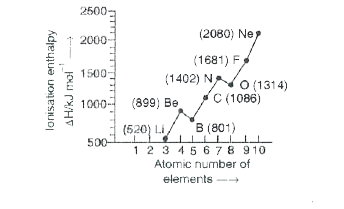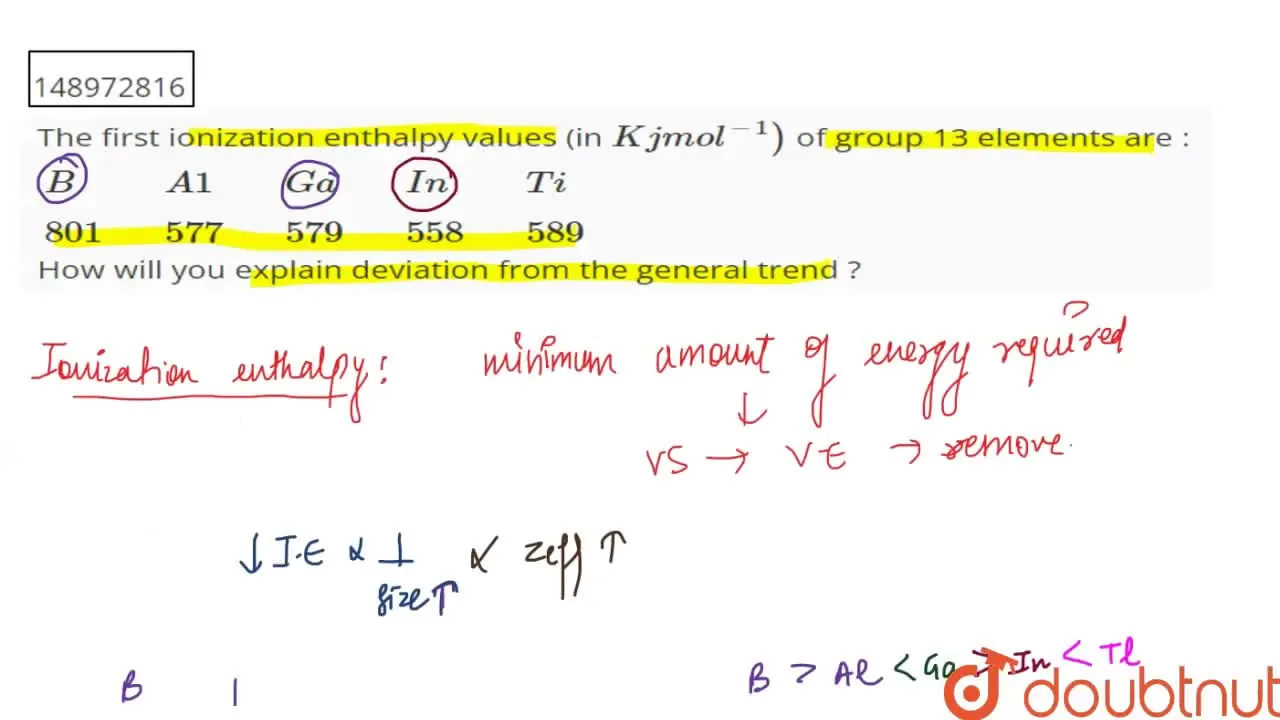The first ionization enthalpy values (in Kjmol−1) of group 13 elements are :
BA1GaInTi801577579558589
How will you explain deviation from the general trend ?
On moving down the group 13 from B to A1, ionization enthalpy decreases as expected due to an increases in atomic size and screening effect (of s- and e-electron of the 2nd shell ) which outweigh the effect of increased nuclear charge. However, ΔiH1 of Ga is only slightly higher (2 kJ mol−1) then that of A1 while that of T1 is much higher than those of A1, Ga and In. These deviations can be explained and follows:
A1 follows immediately after s- element while Ga and In follows after d- block elements and T1 after d- and f- block elements . Since d- and f- electrons shield the valence electrons from the nucleus less effectively than s- and p- electrons therefore valence electrons remain fairly strongly attracted by the nucleus . As a result effective nuclear charge increases and consequently ionization ethalpy increases
Thus as we move from A1 to Ga due to ineffective shielding of the valence electrons by 3d- electrons the effective nuclear charge on Ga is slightly more than on A1. As a result ΔiH1 of Ga is slightly higher than that of A1. Further on moving down the group from Ga to In, the nuclear charge increases by 18 units (49 -31 =18) . Here the shielding effect of all the inner electrons outweighs the effect of the the nuclear charge and hence ΔIH1 of In is lower than that of Ga. On Further moving from In to T1 the nuclear charge further increases by 32 units (81- 49 = 32) this increased nuclear charge outweighs the shielding effect of all the electrons present in the inner shells including those of 4f and 5d- electrons and hence ΔiH1 of T1 is higher than that of In.
Related Playlists
- BOOK - PRADEEPCHAPTER - CLASSIFICATION OF ELEMENTS AND PERIODICITY IN PROPERTIES EXERCISE - NCERT (EXEMPLAR PROBLEMS) (Multiple Choice Questions -I)13videos
CLASSIFICATION OF ELEMENTS AND PERIODICITY IN PROPERTIES
- BOOK - PRADEEPCHAPTER - CLASSIFICATION OF ELEMENTS AND PERIODICITY IN PROPERTIES EXERCISE - NCERT (EXEMPLAR PROBLEMS) (Multiple Choice Questions -II)10videos
CLASSIFICATION OF ELEMENTS AND PERIODICITY IN PROPERTIES
- BOOK - PRADEEPCHAPTER - CLASSIFICATION OF ELEMENTS AND PERIODICITY IN PROPERTIES EXERCISE - NCERT (Questions and exercise )(NCERT INTEXT SOLVED QUESTIONS)10videos
CLASSIFICATION OF ELEMENTS AND PERIODICITY IN PROPERTIES
- BOOK - PRADEEPCHAPTER - CHEMICAL BONDING AND MOLECULAR STRUCTUREEXERCISE - Curiosity Questions2videos
CHEMICAL BONDING AND MOLECULAR STRUCTURE
- BOOK - PRADEEPCHAPTER - ENVIRONMENTAL CHEMISTRYEXERCISE - COMPETITION FOCUS (JEE(Main and Advanced)/Medical Entrance (VI.ASSERTION-REASON) Type II6videos
ENVIRONMENTAL CHEMISTRY
Similar Questions
The first ionization enthalpy values (in kJ mol−1) of group 13 elements are:
BAlGaInTl801577579558589
How would you explain this deviation from the general trend ?View SolutionThe first ionisation enthalpy of group 13 elements are :

Explain this deviation from the general trend.View SolutionIonisation enthalpy (ΔiH kJ mol−1) for the elements of group 13 follows the order.
View SolutionIonisation enthalpy (ΔiH kJ mol−1) for the elements of group 13 follows the order.
View SolutionIonisation enthalpy (ΔtHlinkJmol−1) for the elements of group-13 follows the order
View SolutionThe first (ΔiH1) and the second (ΔiH2) ionization enthalpies (kjmol−1) of three element I, II, III, are given below :
IIIIIΔiH24035491142ΔiH2264010602080
Identify the element which is the likely to be (a ) non- metal (b) an alkali metal ( c) alkaline earth metal.View SolutionExplain the deviation in ionization enthalpy of some elements from the general trend by using Fig. 2.
 View Solution
View SolutionThe table gives the first four ionization energies in kJmol−1 of four elements ( the letters are not the symbols for th elements ) . Which element occurs in Group 13 of the periodic table ?
View SolutionThe first four ionization enthalpies of an element are 578kJmol−1,1817kJmol−1,2745kJmol−1, and 11575kJmol−1. The element is
View SolutionThe first ionization enthalpy (ΔiH) values of the second period elements Li,Be and C are respectively 520,899 and 1086kJmol−1. Predict whther the first ΔiH value for B will be more close to 690 or 990kJmol−1?
View Solution


